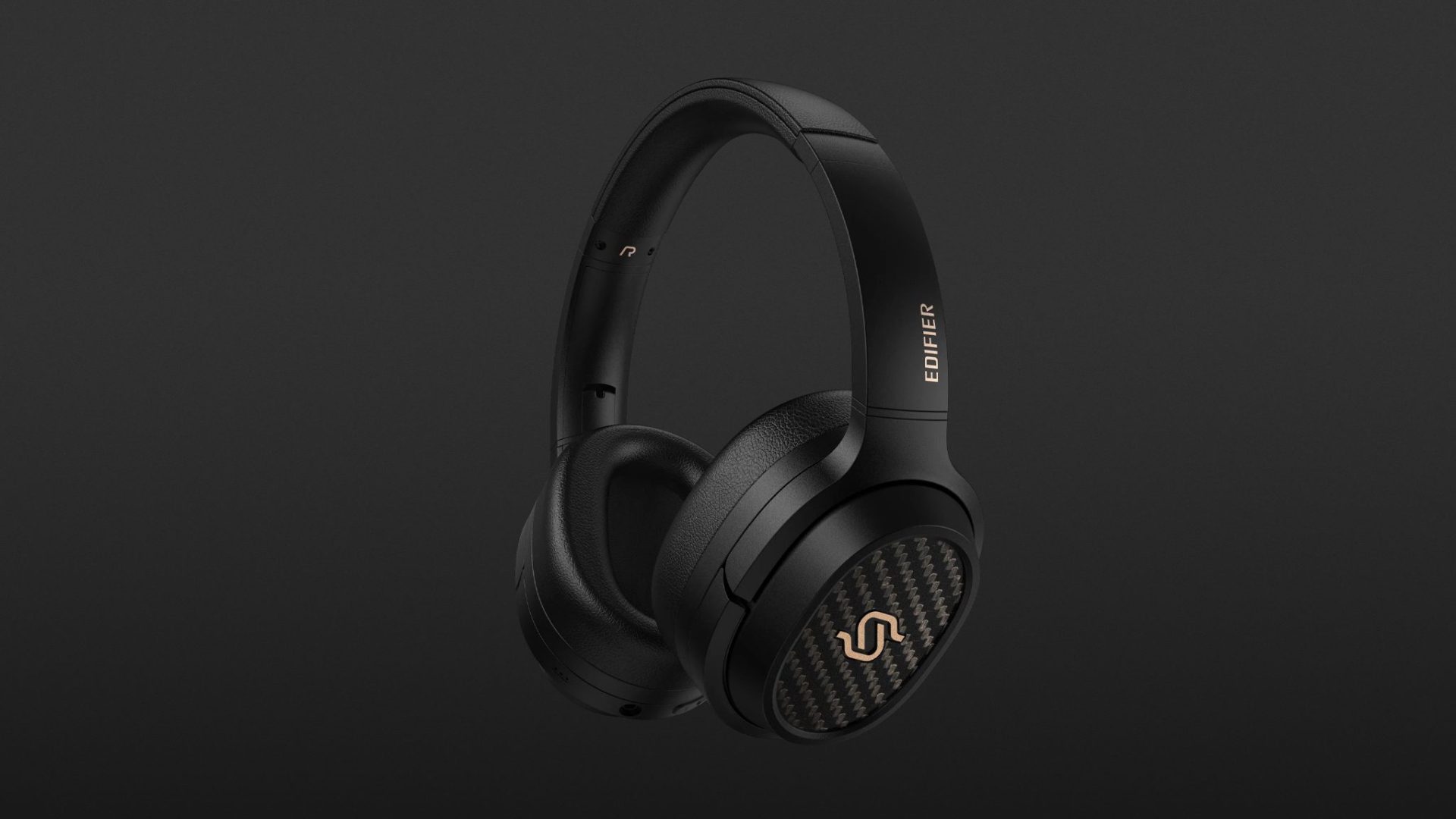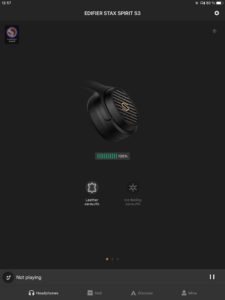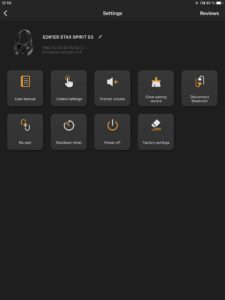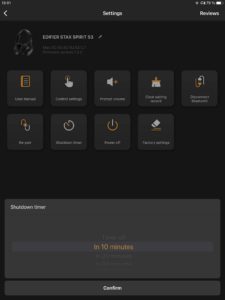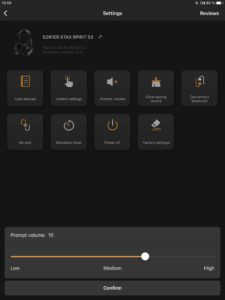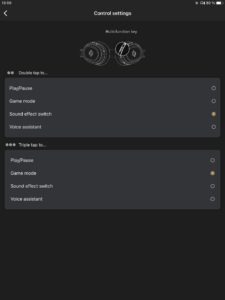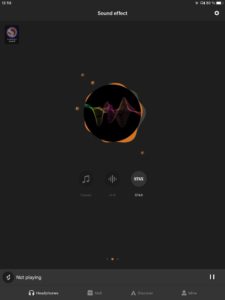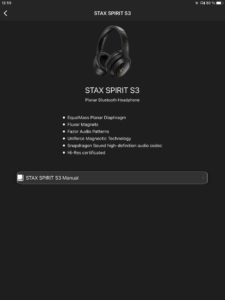The idea of portable, wireless planar headphones is appealing, and so the Edifier Stax Spirit S3 expand the range of Bluetooth over-ears on the market. Even if this launch is not yet fully convincing in all respects, the sound quality offered via wireless with its pure, crisp and detailed reproduction deserves a lot of praise and recognition. Another great advantage of the Edifier Stax Spirit S3 is the immense battery life and fast-charging function. Although the personalisation options via the app seem to need improvement, an EQ section for custom sound settings is a particular omission. There was also no transparency mode or active noise cancellation, unlike with this audio manufacturer’s True Wireless In-Ears.
- Compact, foldable design
- Very long battery life
- Fast charging function
- Low-latency gaming mode
- Multipoint connection with two devices
- Interchangeable ear pads (lambskin and cool mesh)
- Supports "Snapdragon Sound", aptX Adaptive, aptX HD and aptX
- No LDAC and AAC
- Slight background noise perceptible
- App connection without EQ section and few personalisation options
The Chinese audio manufacturer Edifier adds compact, planar-magnetic headphones for mobile use to its range with the Stax Spirit S3, which, in addition to Bluetooth 5.2 and aptX Adaptive, supports the latest technologies through Qualcomm Snapdragon Sound (QSS). There are three sound modes to choose from via the app, while a low-latency mode provides improved synchronicity for movie watching and gaming if required.
The Edifier Stax Spirit S3 come with two pairs of ear cushions, the pre-fitted lambskin leather option and a breathable cool mesh alternative, both of which are very comfortable to wear. At the same time, the closed system with leather pads shields significantly, and this can offer advantages in a noisier environment, as these Bluetooth headphones do not feature active noise cancellation. In contrast, the mesh cover is more permeable to sound from the outside to the inside and vice versa. But, even the fabric version cannot prevent warm ears in summer temperatures. However, apart from the heat build-up, the wearing comfort is impeccable, as the pivoting, tilting and folding earcups can be flexibly adjusted to save space when transported, and the headband size adjustment covers a wide range of head shapes, from petite to large. The weight of 329 grams is also well distributed so that there is no pressure discomfort during longer listening sessions. The fit is taut rather than loose, making them suitable for mobile use; these over-ears do not slip on the head even during an unexpected jog.
Battery life
The Edifier Stax Spirit S3 excel with an exceptionally long battery life of up to 90 hours at high volume, even surpassing the manufacturer’s claim of 80 hours. The fast-charging function is also hugely powerful, providing a good ten hours of capacity after a ten-minute power-up, offering plenty of flexibility for both everyday use and travel. A full charge takes comparatively little time, at just 100 minutes.
As an alternative to wireless operation, these planar headphones can also be used wired via the audio input (3.5 mm) on the right ear cup, although this is not possible passively and requires the system to be switched on. Use via cable during charging is not supported. It is possible to switch between the three sound modes in wired mode, even though the remote buttons are disabled. The Stax Spirit S3 comes with a mini-jack cable with a length of 120 centimetres, a 6.3mm adapter and a USB-C to USB-A charging cable. A high-quality hard case is also included for transportation, and this also accommodates the accessories.
Operation
On a positive note, the wireless connection is very stable, and the planar-magnetic earpieces can easily cover several rooms, including a change of floor. In addition, there is a range of 28 metres over an open space. The Edifier Stax Spirit S3 also support multipoint connections with two devices so that, for example, a smartphone and laptop can be paired at the same time, so you don’t miss a call. Switching between devices is seamless, with no need to stop playback.
The system is switched on by pressing and holding the middle multifunction button, and this also activates pairing mode. If a Bluetooth connection is established, a single press controls playback and is used to answer and end phone calls. In factory settings, a double press communicates with a voice assistant, while a triple press turns the low-latency mode on and off. However, these two functions can be adjusted via the app, so switching between sound modes is also possible. All other button assignments are fixed. The plus and minus buttons control the volume and can also be used for title navigation by holding them down.
App connection
To compensate for differences in sound between the two ear pad variants, it is possible to select which pair is being used in the Edifier Connect app (Android and iOS). For further adjustment, three sound modes are available: “Classic”, “HiFi”, and “Stax”. However, there is no EQ section for custom settings like Edifier provides with its True Wireless in-ears, NeoBuds S (review) and NeoBuds Pro (review). The sound personalisation of the Stax Spirit S3 is not the only thing that could be improved. At the time of our test, the headphone settings, with their timer and limited button assignment options, seemed rather limited, although the manufacturer could always improve them with a firmware update. Supplementary app functions include activating and deactivating the low-latency mode and volume control.
Low latency mode
With aptX Adaptive, the Edifier Stax Spirit S3 support a low-latency audio codec. If this is not available on your device, an improvement in the synchronisation of picture and sound for films, as well as computer and mobile phone games can be achieved in Gaming Mode. A good feature is that the stability of the wireless connection does not suffer from latency optimisation. iOS devices in particular, that have to use Bluetooth standard SBC can benefit from this since the planar receivers exclusively use the aptX family (aptX, aptX HD and aptX Adaptive), and the AAC format is not available. LDAC has also been omitted.
Voice quality on the phone
In a quiet environment, these Bluetooth headphones offered excellent speech intelligibility with a very clean and natural-seeming transmission of one’s voice during phone calls. However, wind noise was not noticeably filtered by the microphone technology, which accordingly dulled the call quality. Intelligibility might also suffer in a busier background environment, as ambient noise was attenuated slightly but not particularly effectively.
Sound
Regardless of the sound setting selected, the Edifier Stax Spirit S3 managed to impress via wireless with a high level of detail and nimble, accurate reproduction. An appealingly pure sound image was also characteristic of these planar headphones, not only when using the higher-resolution audio codecs, but also with the standard SBC option. However, slight background noise from the electronics was noticeable; this set in after a short time when playback was paused.
Compared to the other two modes, the Classic mode conveys the more direct sound impression and has the richest bass reproduction, which reaches deep down. However, the bass reproduction did not sound voluminous. The reproduction in the lower registers was short and concise – without foregrounding, but with a brisk verve. Another characteristic was the full-bodied, powerful reproduction of voices with a charming warmth that gets under your skin and distinguishes itself with its urgency. If you appreciate an imposing reproduction of voices with a high degree of purity and closeness, you will enjoy the Stax Spirit S3 in Classic mode, especially as sibilants tended not to be obtrusive. At the same time, the high-frequency range as a whole seemed neither restrained nor energetic and was well-balanced in itself.
The HiFi mode offered a completely different listening experience with its more expansive stage, which was positioned deeper in the room and was geared towards a spatial presentation. There was also a significant difference from Classic mode in the much leaner low-frequency presentation, with energy focused in the mid to upper bass range for an extremely dry and punchy reproduction. This was followed by a broadly illuminated reproduction of the mid-frequency range with a successful depth gradation, which allowed for precise localisation of signals. The upper registers were present and lively, which favoured a lively, airy presentation.
Stax mode refers to the name of the model as well as to the renowned and esteemed Stax electrostats, whose manufacturer was taken over by Edifier in 2012. From a sound perspective, it seemed more neutrally tuned than the full, darker Classic mode and the open, brighter HiFi mode. Accordingly, the bass response was in the middle and seemed tight, but it had more substance than in HiFi mode and reached further down. Another strength was the reproduction of voices, which was somewhat plainer and less substantial but more realistic than in Classic mode. The treble reproduction was more restrained than in HiFi and Classic mode, and it seemed more gentle and relaxed than spirited.
Technical specifications
- Ear couplingOver-ear
- Typeclosed
- Transducer principleplanar magnetic
- Frequency response (headphones)20 - 40.000 Hz
- Impedance24 ohms
- Sound pressure level (SPL)94±3 dB
- Weight with cable344 g
- Weight without cable329 g
- Cable length120 cm
What's in the box
- Mini jack cable
- 6.35mm stereo jack
- USB-C to USB-A charging cable
- Ear Cushions Pick (tool for changing ear cushions)
- Two fabric pouches, each with a cool mesh ear cushion
- Hard shell case
Special features
- BT codecs: SBC, aptX, aptX HD, aptX Adaptive
- BT version: 5.2
- BT profiles: A2DP, AVRCP, HFP





